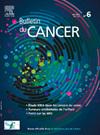[子宫内膜癌 2023 年 FIGO 分类的实际应用]。
IF 1.1
4区 医学
Q4 ONCOLOGY
引用次数: 0
摘要
自 2009 年上一次 FIGO 分类以来,许多研究和建议都有助于改善子宫内膜癌的治疗。分子分类(包括 POLE、MMR 和 P53 状态)的引入,通过定义特定的患者群体,对这些癌症进行了更好的分类,从而使手术管理和辅助治疗更具针对性。欧洲妇科肿瘤学会(ESGO)、放射治疗与肿瘤学会(ESTRO)和解剖病理学学会(ESP)在 2021 年指南中开发的分子和组织学分类数据和分析已被用于制定新的 2023 年 FIGO 子宫内膜癌分类。我们正在见证 FIGO 分类的演变,从纯粹的解剖学分类转变为基于风险的分类。病理报告中必须明确肿瘤的组织学类型、子宫内膜样肿瘤的分级、有无淋巴管间隙侵犯以及肿瘤的范围(子宫肌层侵犯、浆膜、宫颈、阴道、附件或邻近器官受累)。这些要点已被纳入 2023 年 FIGO 分类法,将有助于对肿瘤进行精确分期。本文旨在根据 2023 年 FIGO 新的子宫内膜癌分类法阐明并简化患者的分期。本文章由计算机程序翻译,如有差异,请以英文原文为准。
Utilisation en pratique de la classification FIGO 2023 du cancer de l’endomètre
Depuis la dernière classification FIGO de 2009, de nombreuses études et recommandations ont participé à l’amélioration de la prise en charge du cancer de l’endomètre. L’introduction de la notion de classification moléculaire (statut POLE, MMR et P53) a permis de mieux catégoriser ces cancers en introduisant des groupes précis de patientes, ainsi que d’adapter au mieux la prise en charge chirurgicale et le traitement adjuvant. Les données et les analyses sur la classification moléculaire et la classification histologique développées dans les récentes recommandations des sociétés européennes d’oncologie gynécologique (ESGO), de radiothérapie et d’oncologie (ESTRO) et d’anatomopathologie (ESP) de 2021 ont été utilisés pour développer la nouvelle Classification FIGO 2023 du cancer de l’endomètre. Nous assistons à une évolution de la classification FIGO avec passage d’une classification purement anatomique à une classification de niveau de risque. Il est important dans les comptes rendus d’anatomopathologie de spécifier le type histologique de la tumeur, le grade pour les tumeurs endométrioïdes, la présence ou l’absence d’emboles et l’extension de la tumeur (invasion myométriale, atteinte de la séreuse, atteinte du col utérin, du vagin, des annexes ou des organes du voisinage). Ces points essentiels entrent en compte dans la classification FIGO 2023 et vont permettre de rendre un staging précis de la tumeur. Cet article a pour but de clarifier et de simplifier la classification des patientes selon la nouvelle classification FIGO 2023 du cancer de l’endomètre.
Since the last FIGO classification in 2009, numerous studies and recommendations have contributed to improving the management of endometrial cancer. The introduction of molecular classification (including POLE, MMR, and P53 status) has enabled better categorization of these cancers by defining specific patient groups, thus allowing for more tailored surgical management and adjuvant treatment. The data and analyses on molecular and histological classification developed in the 2021 guidelines from the European Societies of Gynecologic Oncology (ESGO), Radiation Therapy and Oncology (ESTRO), and Anatomical Pathology (ESP) have been utilized to develop the new 2023 FIGO classification for endometrial cancer. We are witnessing an evolution of the FIGO classification, shifting from a purely anatomical classification to a risk-based classification. It is important in pathology reports to specify the histological type of the tumor, the grade for endometrioid tumors, the presence or absence of lymphovascular space invasion, and the extent of the tumor (myometrial invasion, involvement of the serosa, cervix, vagina, adnexa, or neighboring organs). These essential points are included in the 2023 FIGO classification and will enable precise staging of the tumor. This article aims to clarify and simplify the classification of patients according to the new 2023 FIGO classification for endometrial cancer.
求助全文
通过发布文献求助,成功后即可免费获取论文全文。
去求助
来源期刊

Bulletin Du Cancer
医学-肿瘤学
CiteScore
1.90
自引率
16.70%
发文量
224
审稿时长
37 days
期刊介绍:
Without doubt, the ''Bulletin du Cancer'' is the French language publication of reference in the field of cancerology. Official organ of the French Society of Cancer, this journal covers all the information available, whether in the form of original articles or review articles, but also clinical cases and letters to the editor, including various disciplines as onco-hematology, solids tumors, medical oncology, pharmacology, epidemiology, biology as well as fundamental research in cancerology. The journal proposes a clinical and therapeutic approach of high scientific standard and regular updates in knowledge are thus made possible. Articles can be submitted in French or English.
 求助内容:
求助内容: 应助结果提醒方式:
应助结果提醒方式:


